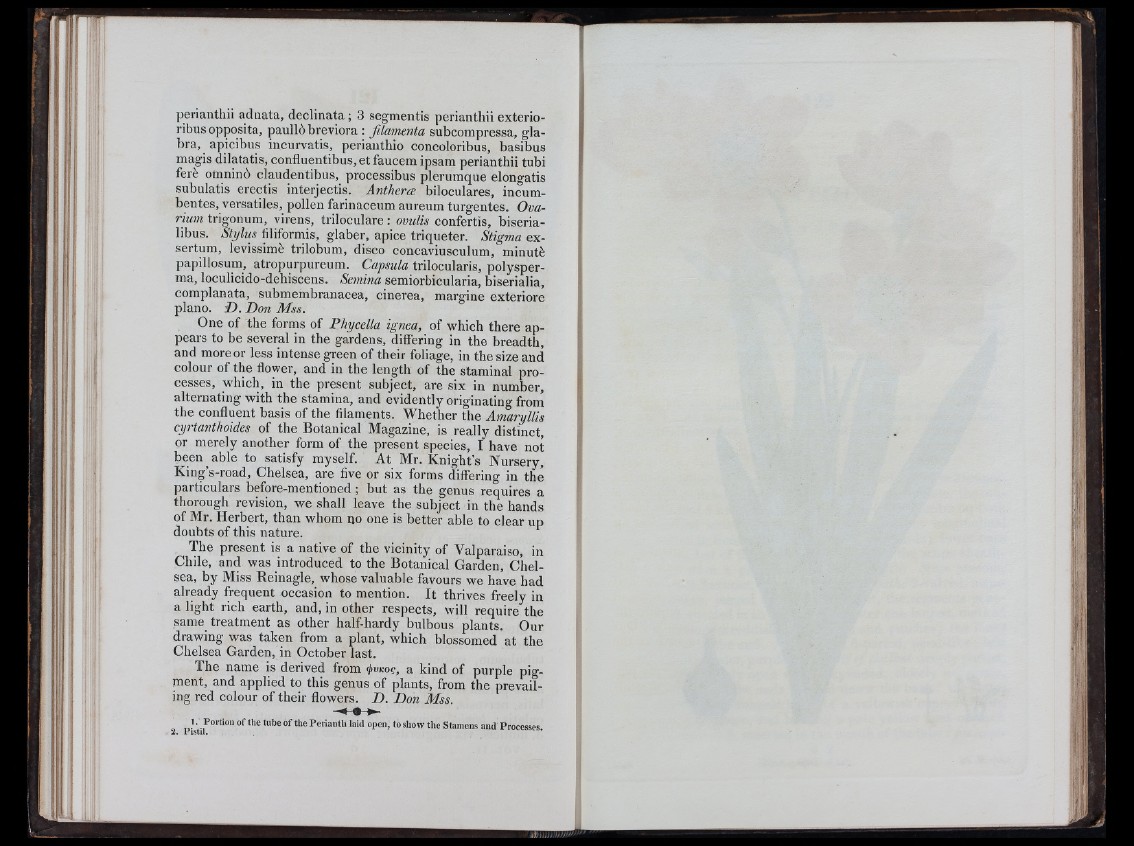
perianthii adnata, declinata ; 3 segmentis perianthii exterio-
ribus opposite, paullô breviora : filamenta subcompressa, glabra,
apicibus incurvatis, periauthio concoloribus, basibus
magis dilatatis, confluentibus, et faucem ipsam perianthii tubi
ferè omninô claudentibus, processibus plerumque elongatis
subulatis erectis interjectis. Antheræ biloculares, incum-
bentes, versatiles, pollen farinaceum aureum turgentes. Ovarium
trigonum, virens, triloculare : ovulis confertis, biseria-
libus. Stylus filiformis, glaber, apice triqueter. Stigma ex-
sertum, levissimè trilobum, disco concaviusculum, minuté
papillosum, atropurpureum. Capsula trilocularis, polysperma,
loculicido-dehiscens. Semina semiorbicularia, biserialia,
complanata, submembranacea, cinerea, margine exteriore
piano. £). Don Mss.
One of the forms of Phycella ignea, of which there appears
to be several in the gardens, differing in the breadth,
and more or less intense green of their foliage, in the size and
colour of the flower, and in the length of the staminal processes,
which, in the present subject, are six in number,
alternating with the stamina, and evidently originating from
the confluent basis of the filaments. Whether the Amaryllis
cyrtanthoides of the Botanical Magazine, is really distinct,
or merely another form of the present species, I have not
been able to satisfy myself. At Mr. Knight’s Nursery,
King’s-road, Chelsea, are five or six forms differing in the
particulars before-mentioned ; but as the genus requires a
thorough revision, we shall leave the subject in the hands
of Mr. Herbert, than whom no one is better able to clear up
doubts of this nature.
The present is a native of the vicinity of Valparaiso, in
Chile, and was introduced to the Botanical Carden, Chelsea,
by Miss Reinagle, whose valuable favours we have had
already frequent occasion to mention. It thrives freely in
a light rich earth, and, in other respects, will require the
same treatment as other half-hardy bulbous plants. Our
drawing was taken from a plant, which blossomed at the
Chelsea Carden, in October last.
The name is derived from ÿvKoç, a kind of purple pigment,
and applied to this genus of plants, from the prevailing
red colour of their flowers. D. Don Mss.
A ■ Bortiou o f tlie tube o f the Perian th laid open, to sh ow th e Stamens and Processes.
2 . 1 istll.